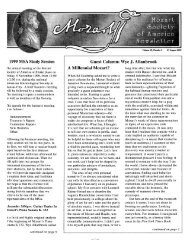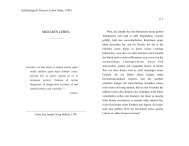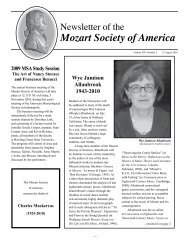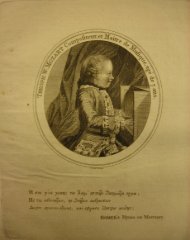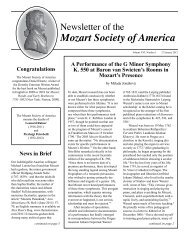January 2002 - Mozart Society of America
January 2002 - Mozart Society of America
January 2002 - Mozart Society of America
Create successful ePaper yourself
Turn your PDF publications into a flip-book with our unique Google optimized e-Paper software.
Geographical/Historical Note.<br />
Most <strong>of</strong> the story <strong>of</strong> the <strong>Mozart</strong><br />
Requiem is centered on the Hapsburg<br />
capital <strong>of</strong> Vienna. However,<br />
other and lesser known locations<br />
that affect the story-some <strong>of</strong><br />
which are shown only on largescale<br />
maps-are at Niederfellabrunn<br />
and N eiderhollabrunn<br />
(rural outposts northeast <strong>of</strong> Vienna<br />
near Stockerau), Wiener-Neustadt<br />
(south <strong>of</strong> Vienna), Stuppach,<br />
Gloggnitz, Schottwien, and<br />
Semmering, all close to each other<br />
and lying to the southwest.<br />
Until the death <strong>of</strong> the last male<br />
heir in 1827, the substantial castle<br />
at Schloss Stuppach had been the<br />
seat <strong>of</strong> the Walsegg family for<br />
generations. After World War II,<br />
the castle fell into disrepair, al<br />
though work done near the end<br />
<strong>of</strong> the twentieth century has restored it to<br />
its former grandeur. Another edifice, a<br />
very special tomb for a very special<br />
woman, once stood on the castle grounds<br />
in an area known as the Stuppacher Au, or<br />
Park near the river Schwarza. Unfortunately,<br />
over the years it became so badly<br />
vandalized that all sign <strong>of</strong> it disappeared.<br />
Until the mid-nineteenth century<br />
Vienna, the Royal and Imperial capital <strong>of</strong><br />
the Hapsburg empire, consisted <strong>of</strong> the<br />
centuries-old walled and fortified Inner<br />
City surrounded by suburbs, most <strong>of</strong><br />
which were, in turn, encircled by an outer<br />
defensive line.<br />
The Tomb's History. The following is<br />
extracted from the death registers <strong>of</strong> the<br />
parish church in Schottwien:<br />
On 14 February 1791 died at Schloss<br />
Stuppach and was interred here in the<br />
family crypt on the 16th, the high and<br />
noble born Anna Countess von<br />
Walsegg nee von Flammberg in her<br />
20th year, celebrated by me Mattheus<br />
Richter and priest here.<br />
The death <strong>of</strong> the Countess was to trigger a<br />
series <strong>of</strong> events-some <strong>of</strong> which are still<br />
hotly debated to this day-when her<br />
husband, Franz Paula Josef Anton, Count<br />
von Walsegg, a wealthy landowner from<br />
Stuppach in Lower Austria, commissioned<br />
two tributes for his departed wife.<br />
One was an elaborate tomb ordered from<br />
The Tomb <strong>of</strong> Countess Walsegg<br />
An artist's rendering <strong>of</strong> the tomb <strong>of</strong> General Field-Marshall Gideon<br />
von Laudon. It served as the model for the tomb ordered by Count<br />
Walsegg after the death <strong>of</strong> his wife Anna. The original <strong>of</strong> Laudon's<br />
tomb still stands in the Habersdorf suburb <strong>of</strong> Vienna.<br />
the Vienna architect Johann Enrici and<br />
sculptor Johann Martin Fischer for<br />
erection in meadows adjacent to Schloss<br />
Stuppach and intended as the final resting<br />
place for the remains <strong>of</strong> the Count's late<br />
wife. The other was a requiem mass<br />
commissioned in circumstances <strong>of</strong> some<br />
secrecy from Wolfgang Amadeus <strong>Mozart</strong>,<br />
then living at City 970 in the Rauhensteingasse<br />
in Vienna. The tomb cost 3000<br />
gulden, probably more than ten times the<br />
amount paid for the Requiem.<br />
The commissions were channeled<br />
through Walsegg's lawyer, Doctor <strong>of</strong> Law,<br />
Johann Nepomuk Sortschan in Vienna,<br />
who probably drew up a contract giving<br />
exclusive ownership <strong>of</strong> the <strong>Mozart</strong> work<br />
to the Count. Information about Sortschan<br />
is scant, but it is known that he was born<br />
in Znaim, northwest <strong>of</strong> Vienna, and that<br />
he was given a Letter <strong>of</strong> Freedom on<br />
9 November 1792 to be married in the<br />
Dominican Church in Vienna. In the 1801<br />
edition Court and State Schematismus<br />
published by Joseph Gerold, Sortschan is<br />
listed as being in Court service and resident<br />
at City 459. It was at his <strong>of</strong>fice that<br />
the 1799 inspection <strong>of</strong> Count Walsegg's<br />
score was conducted, with Nissen and<br />
Abbe Stadler, when doubts concerning the<br />
SiiBmayr completion flared and by which<br />
time the Requiem had already been<br />
published. After the examination the<br />
score was returned to Count Walsegg and<br />
not seen again for many years.<br />
-4-<br />
Walsegg's financial emissary<br />
in Vienna was Franz Anton<br />
Leitgeb, who had interests in a<br />
gypsum business in the Schottwien<br />
area. He visited Vienna<br />
frequently with his wife<br />
Margarete staying at the "Golden<br />
Ox" inn a little way from the<br />
walled Inner City. In time,<br />
Leitgeb, who had part Turkish<br />
ancestry became known as the<br />
fabled "gray messenger,"<br />
although Walsegg seems to have<br />
chosen him because he was a<br />
keen amateur musician and a<br />
competent business man.' He is<br />
buried in a cemetery not far from<br />
Schottwien.<br />
It is generally believed that<br />
<strong>Mozart</strong> received the commission<br />
for the Requiem in the summer <strong>of</strong><br />
1791, but if the Count's instructions<br />
for both the Requiem and the tomb<br />
reached Sortschan at the same time, it is<br />
possible that <strong>Mozart</strong> received the commission<br />
earlier. On the other hand, if the<br />
Count was to be given exclusive ownership<br />
<strong>of</strong> the Requiem, there may well have<br />
been a delay at Sortschan's <strong>of</strong>fice because<br />
<strong>of</strong> legal and contractual matters.<br />
Maria Anna Theresa Prenner Edlen<br />
von Flammberg-Prenner was the family<br />
name while Flammberg was the family<br />
priidikat or title-was born on<br />
15 September 1770 in the family mansion<br />
near Neiderfellabrunn. The family was<br />
steeped in music and Anna's father<br />
Wilhelm conducted the local church<br />
choir. Little else is known about the<br />
family.<br />
It is uncertain how, when, or where<br />
Anna met Count Walsegg, possibly in<br />
Vienna where he is known to have owned<br />
a house (at City 522) and the Prenner<br />
family is believed to have also owned<br />
one. On 9 September 1787, the 24-yearold<br />
Count married the 16-year-old Anna<br />
in the pilgrimage church <strong>of</strong> Maria Schutz<br />
at Semmering, with which the Walsegg<br />
family had a long association. Because <strong>of</strong><br />
the bride's young age, a dispensation was<br />
required for the marriage. The couple was<br />
to enjoy only a few years <strong>of</strong> happiness at<br />
the Stuppach mansion.<br />
Schloss Stuppach boasted a large<br />
kitchen, two pantries, two rooms for<br />
servants, a small private chapel, two




